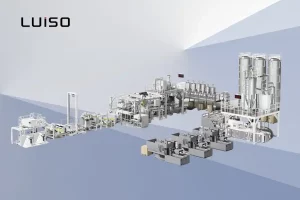The plastics industry has undergone a significant transformation in recent years thanks to the implementation of automation technologies. The demand for greater efficiency, precision, and sustainability has driven companies to integrate plastic automation machines into their production processes. This advancement not only optimizes manufacturing times but also improves the quality of the final product and reduces operational costs.
In this article, we will explore how automation is redefining the industry, the key benefits it brings, and the most relevant trends today.
The Role of Automation in Plastic Production
Automation in plastic manufacturing is based on the integration of intelligent systems, advanced robotics, and specialized software that allow continuous operation with minimal human intervention. This includes everything from handling raw materials to quality control and packaging of the finished product.
Manufacturers have incorporated technologies such as industrial robots, machine vision systems, and programmable logic controllers (PLC) to optimize every stage of the production process. With these advancements, production lines can operate with greater precision, reducing material waste and increasing productivity.
Key Processes Benefited by Automation
- Injection Molding: Automated equipment optimizes the injection of polymers into molds, ensuring uniformity in each piece and reducing defects.
- Plastic Extrusion: Automated systems monitor temperature, pressure, and material speed, ensuring homogeneous and stable extrusion.
- Thermoforming: Automation allows for better control over temperature and pressure in plastic sheet molding, improving the final quality.
- Plastic Recycling: Advanced sensors and robots improve the separation and classification of plastic waste, increasing recycling efficiency.
- Packaging and Labeling: Robotic systems streamline the placement of labels and packaging of plastic products with high precision.
Key Benefits of Plastic Automation Machines
The incorporation of plastic automation machines has generated a series of tangible benefits in the industry, allowing companies to improve their competitiveness and reduce the environmental impact of their operations.
1. Greater Efficiency and Productivity
Automated systems work with precision and speed, reducing cycle times and allowing for continuous production. This results in a significant increase in production capacity without the need to expand infrastructure.
For example, in injection molding, automation ensures process repeatability, reducing variations in product quality and maximizing operational efficiency.
2. Reduction of Errors and Material Waste
The use of advanced sensors and control systems minimizes manufacturing errors, reducing the rate of defective products. This is especially critical in the production of plastic components for sectors like automotive and medical, where quality standards are strict.
Additionally, automation in the plastic industry has optimized the consumption of raw materials, reducing waste and encouraging more sustainable practices.
3. Optimization of Energy Consumption
The new generations of plastic automation machines are designed to operate with lower energy consumption. Energy-efficient systems and optimized electric motors have reduced electricity demand in production plants, contributing to lower operational costs and reduced environmental impact.
For example, some production lines use smart sensors that automatically adjust energy consumption based on the workload, optimizing performance without wasting resources.
4. Improved Workplace Safety
Automation has reduced the need for human intervention in hazardous processes, minimizing workplace accidents. Robotic equipment handles repetitive and high-risk tasks, allowing operators to focus on supervision and quality control activities.
In the handling of molten plastics, for example, robotic arms ensure safe and precise operations, eliminating workers’ exposure to extreme temperatures.
5. Integration with Industry 4.0
Automation in plastic manufacturing has evolved towards Industry 4.0, where connectivity and artificial intelligence play a crucial role. Advanced systems allow for the collection and analysis of real-time data, optimizing decision-making and predictive maintenance.
Some factories have implemented digital twins, virtual simulations that replicate the production process in real-time, allowing for adjustments and improvements without halting production.
Current Trends in Plastic Automation
Technological advances continue to revolutionize plastic production, with emerging trends aimed at improving efficiency, sustainability, and adaptability in the sector.
1. Use of Artificial Intelligence in Production
Artificial intelligence (AI) is transforming the industry through predictive analysis and process optimization. Advanced algorithms can detect patterns in production, anticipate machinery failures, and suggest real-time adjustments to improve efficiency.
For example, some manufacturers have implemented machine learning systems that adjust molding parameters based on environmental variables, reducing waste and improving the final product’s quality.
2. Increased Sustainability in Production
Automation has enabled the creation of more sustainable processes, reducing material consumption and promoting the reuse of recycled plastics.
- Automatic separation and classification of recyclable plastics to improve recycling efficiency.
- Plastic automation machines designed to work with bioplastics and biodegradable materials.
- Implementation of closed-loop systems, where waste generated in production is reused in new parts.
3. Cobots: Collaboration Between Humans and Robots
Collaborative robots (cobots) are changing the way operators interact with machines. These devices work alongside employees, assisting in specific tasks and improving efficiency without replacing human intervention.
In the production of plastic parts for automotive, for example, cobots handle assembly and quality verification, reducing production time and ensuring precision in each component.
4. 3D Printing in the Plastic Industry
Additive manufacturing has revolutionized plastic part production, allowing the creation of prototypes and custom products with less material consumption and reduced lead times.
New 3D printers specialized in plastics have started to be integrated into production lines, offering advantages such as:
- On-demand production without the need for large inventories.
- Customization of products for different industries.
- Use of recycled materials in the printing process.
The Future of Automation in the Plastic Industry
The adoption of plastic automation machines has taken manufacturing to a new level, optimizing production, reducing costs, and improving sustainability in the sector. With the integration of artificial intelligence, advanced robotics, and more efficient processes, companies can remain competitive and meet the demands of the current market.
The industry continues to evolve, and those companies that invest in automated technology will be better positioned to face future challenges.
Want to optimize your production with cutting-edge technology?
If you are looking for solutions in automation for the plastic industry, contact us and discover how our equipment can improve your efficiency and reduce your operational costs.




